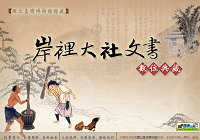|
|
| Resource name | National Taiwan Museum—Lahodoboo Documents—Speak |
|---|---|
| URL | http://formosa.ntm.gov.tw/dasir/index.asp |
| Attached picture |  |
| Language | Chinese |
| Introduction | "Lahodoboo( An-li Dashe)Documents" are some of the best resources for researching early Taiwan's cultural development from the Qing dynasty to the Japanese Colonial era. The "Lahodoboo" are the tribal gathering places of the Plains Aborigine "Pazeh tribe" during the Qing dynasty. It was said to be consisted of nine tribes, with the most well-known being the tribes located at the present day An-li and Dashe Shengang District of Taichung city thus also known as Lahodoboo. The central regions in Taiwan to first undergo development was the Lahodoboo region and it holds a prominent position in the pioneer history of Taiwan. "Lahodoboo Documents" contents are mainly the documents and contracts left behind by Chief Pan of Lahodoboo. There are 268 items in the Plains Aborigine "Lahodoboo" of documents and artifacts collection of the National Taiwan Museum. Most of the items (around 250) were transferred over by the then Taichung Provincial Library while the other 18 items were part of the collections of the predecessor of the Museum - "Taiwan Viceroy’s office Museum". Most of the "Lahodoboo Documents" and artifacts taken from the Taichung Provincial Library by the Museum belonged to the collection of the Japanese Colonial era's Taichu Prefecture Education Museum. "Lahodoboo Documents" span from 1716 to 1918 with the majority of the documents from the reigns of Qianlong and Jiaqing Emperors. The Lahodoboo related documents and artifacts in the collection of the National Taiwan Museum can be divided into seven categories: 1. Old documents: including instructions, messenger cards, letters, signs, licenses, household signs 2. Inscription copies (rubbings) 3. Pictures, printing plates and inscription boards of Lahodoboo 4. Land survey records, lawsuit and settlement records of the nine tribes in Lahodoboo 5. Maps such as the Map of Upstream Dajia River, Defense Map of the North-East Lahodoboo 6. Photographs such as the photo of the Lahodoboo entrance gate, portrait of Chief Pan 7. House models such as the model of the Chief Pan's mansion awarded by the court. These are important resources for learning about the community relations of central Taiwan and the historical develop of the Pazeh tribe under Qing rule during the 18th and 19th centuries. |
| Cooperation | National Taiwan Museum |
Total Visitors:5915796
Last Updated:2024.04.20 |
 |


